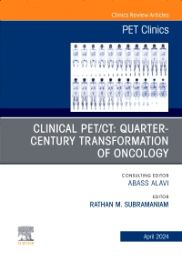Clinical PET/CT: Quarter-Century Transformation of Oncology, An Issue of PET Clinics, 1st Edition
Date of Publication: 02/2024
In this issue of PET Clinics, guest editor Dr. Rathan M. Subramaniam brings his considerable expertise to the topic of Clinical PET/CT: Quarter-Century Transformation of Oncology. The first PET-CT prototype for clinical evaluation was installed at the University of Pittsburgh Medical Center in 1998, and combined PET/CT scanners perform almost all PET scans today. These combined scans help pinpoint abnormal metabolic activity and may provide more accurate diagnoses than the two scans performed separately. In this issue, top experts discuss specific cancers where PET/CT is used and how it has transformed diagnosis in that area.
In this issue of PET Clinics, guest editor Dr. Rathan M. Subramaniam brings his considerable expertise to the topic of Clinical PET/CT: Quarter-Century Transformation of Oncology. The first PET-CT prototype for clinical evaluation was installed at the University of Pittsburgh Medical Center in 1998, and combined PET/CT scanners perform almost all PET scans today. These combined scans help pinpoint abnormal metabolic activity and may provide more accurate diagnoses than the two scans performed separately. In this issue, top experts discuss specific cancers where PET/CT is used and how it has transformed diagnosis in that area.
Key Features
- Contains 14 relevant, practice-oriented topics on PET/CT transformation of oncology, including breast cancer, hepatobiliary and pancreatic cancer, gastric and colonic cancers, multiple myeloma, prostate cancer, and more.
- Provides in-depth clinical reviews on how PET/CT has transformed oncology over the last 25 years, offering actionable insights for clinical practice.
- Presents the latest information on this timely, focused topic under the leadership of experienced editors in the field. Authors synthesize and distill the latest research and practice guidelines to create clinically significant, topic-based reviews.
Author Information
By Rathan M. Subramaniam, MD, PhD, MPH MClinEd, FRANZCR, MRSNZ, Associate Professor of Radiology, Russell H Morgan Department of Radiology and Radiologic Sciences, John Hopkins Medical Institutions












